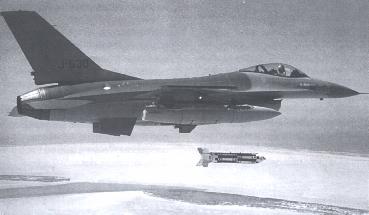Fighter Jet News
F-16 Fighting Falcon News
Dutch air force to scrap cluster bombs for their F-16s
April 20, 2008 (by
Lieven Dewitte) -
The Dutch air force will dispose of their controversial CBU-87 cluster bombs in accordance with the Oslo Process.
Cluster bombs were introduced during the Second World War. When dropped, each bomb makes many little explosions covering a larger area then a typical bomb would cover. The bomb is not necessarily used for precision, but for destroying multiple targets at once or making sure something gets hit along with the outer perimeter of the target getting hit as well.
They are often used to cover a large area, for example to bomb an airport. As they are equipped with a detonator but not with a self-destruct mechanism they can remain a threat to civilians for several decades after a conflict has ended, just like landmines.
Many children in combat zones are killed or injured after they find "bomblets" that have failed to explode on impact and play with them. According to some sources, ninety-eight percent of cluster bomb victims are in fact civilians.
Cluster bombs are not specifically covered by any international legal instrument, although the general rules of international humanitarian law aimed at protecting civilians apply as they do to the use of all other weapons. An initiative by the Government of Norway launched an international treaty development process commonly known as the Oslo Process in February 2007 to prohibit cluster munitions that cause unacceptable harm to civilians by 2008.
On May 7, 1999, a CBU-87 was responsible for one of the most serious incident involving civilian deaths and the use of cluster bombs, the Cluster bombing of Niš, Serbia. The mid-day NATO attack on Niš airfield killed fourteen civilians and injured twenty-eight.
In a letter to the Lower House announcing the decision, Dutch Defence Minister Eimert van Middelkoop says the cluster bombs are responsible for an unacceptable degree of human suffering.
Another type of cluster bomb, the M261 missile head used by Dutch Apache helicopters will continue to be used. The M261 only contains only nine submunitions, making it only as dangerous as any other unexploded ordnance. This is in line with international agreements to ban cluster bombs with more than ten submunitions.
As a result of the decision all CBU-87s in the Dutch inventory will now be destroyed.
Next month an international conference on this issue will be held in Dublin.
During Desert Storm the US Air Force dropped 10,035 CBU-87s. During Allied Force the US dropped about 1,100 cluster bombs, and most of these were CBU-87s.
The bomb was introduced in 1986 and its list price is set at $14,000 per bomb. When the CBU-87 Combined Effects Munition is used in conjunction with the Wind Corrected Munitions Dispenser guidance tail kit, it is designated as CBU-103.
They are often used to cover a large area, for example to bomb an airport. As they are equipped with a detonator but not with a self-destruct mechanism they can remain a threat to civilians for several decades after a conflict has ended, just like landmines.
Many children in combat zones are killed or injured after they find "bomblets" that have failed to explode on impact and play with them. According to some sources, ninety-eight percent of cluster bomb victims are in fact civilians.
Cluster bombs are not specifically covered by any international legal instrument, although the general rules of international humanitarian law aimed at protecting civilians apply as they do to the use of all other weapons. An initiative by the Government of Norway launched an international treaty development process commonly known as the Oslo Process in February 2007 to prohibit cluster munitions that cause unacceptable harm to civilians by 2008.
On May 7, 1999, a CBU-87 was responsible for one of the most serious incident involving civilian deaths and the use of cluster bombs, the Cluster bombing of Niš, Serbia. The mid-day NATO attack on Niš airfield killed fourteen civilians and injured twenty-eight.
In a letter to the Lower House announcing the decision, Dutch Defence Minister Eimert van Middelkoop says the cluster bombs are responsible for an unacceptable degree of human suffering.
Another type of cluster bomb, the M261 missile head used by Dutch Apache helicopters will continue to be used. The M261 only contains only nine submunitions, making it only as dangerous as any other unexploded ordnance. This is in line with international agreements to ban cluster bombs with more than ten submunitions.
As a result of the decision all CBU-87s in the Dutch inventory will now be destroyed.
Next month an international conference on this issue will be held in Dublin.
During Desert Storm the US Air Force dropped 10,035 CBU-87s. During Allied Force the US dropped about 1,100 cluster bombs, and most of these were CBU-87s.
The bomb was introduced in 1986 and its list price is set at $14,000 per bomb. When the CBU-87 Combined Effects Munition is used in conjunction with the Wind Corrected Munitions Dispenser guidance tail kit, it is designated as CBU-103.
Additional images:


An inert BL-755 cluster bomb under a Belgian viper. This weapon is now out of service. [f16.falcon photo]
Related articles:
External link:
Forum discussion:
Tags
- Lockheed Martin awarded $52.9 M contract for Wind Corrected Munitions Dispenser kits (2005-05-20)
- F-16 Fighting Falcon news archive
External link:
Forum discussion:
- Start a discussion about this article in the F-16.net forum.
Tags

